Maat
Maat or Maʽat (Egyptian: mꜣꜥt /ˈmuʀʕat/, Coptic: ⲙⲉⲓ)[1] refers to the ancient Egyptian concepts of truth, balance, order, harmony, law, morality, and justice. Maat was also the goddess who personified these concepts, and regulated the stars, seasons, and the actions of mortals and the deities who had brought order from chaos at the moment of creation. Her ideological opposite was Isfet (Egyptian jzft), meaning injustice, chaos, violence or to do evil.
| Maat ⲙⲉⲓ | ||||
|---|---|---|---|---|
Goddess of truth, justice, wisdom, the stars, law, morality, order, harmony, the seasons, and cosmic balance | ||||
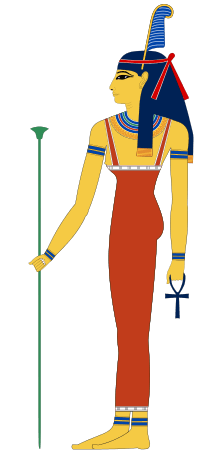 Maat was both the goddess and the personification of truth and justice. Her ostrich feather represents truth. | ||||
| Name in hieroglyphs | ||||
| Major cult center | All ancient Egyptian cities | |||
| Symbol | scales, ostrich feather | |||
| Parents | Ra and Hathor | |||
| Consort | Thoth | |||
| Offspring | Seshat | |||
| Part of a series on |
| Ancient Egyptian religion |
|---|
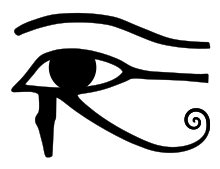 |
|
Beliefs |
|
Practices
|
|
Deities (list) |
|
Locations |
|
Symbols and objects
|
|
Related religions
|
|
|
Pronunciation
Cuneiform texts indicate that the word m3ˤt was pronounced /múʔʕa/ during the New Kingdom of Egypt, having lost the feminine ending t.[2] Vowel assimilation of u to e later produced the Coptic word ⲙⲉⲉ/ⲙⲉ "truth, justice".[3]
History
The earliest surviving records indicating that Maat is the norm for nature and society, in this world and the next, were recorded during the Old Kingdom of Egypt, the earliest substantial surviving examples being found in the Pyramid Texts of Unas (ca. 2375 BCE and 2345 BCE).[4]
Later, when most goddesses were paired with a male aspect, her masculine counterpart was Thoth, as their attributes are similar. In other accounts, Thoth was paired off with Seshat, goddess of writing and measure, who is a lesser-known deity.
After her role in creation and continuously preventing the universe from returning to chaos, her primary role in ancient Egyptian religion dealt with the Weighing of the Heart that took place in the Duat.[5] Her feather was the measure that determined whether the souls (considered to reside in the heart) of the departed would reach the paradise of the afterlife successfully.
Pharaohs are often depicted with the emblems of Maat to emphasise their role in upholding the laws and righteousness.[6]
Principle
.jpg)
Maat represents the ethical and moral principle that every Egyptian citizen was expected to follow throughout their daily lives. They were expected to act with honor and truth in matters that involve family, the community, the nation, the environment, and the gods.[7]
Maat as a principle was formed to meet the complex needs of the emergent Egyptian state that embraced diverse peoples with conflicting interests.[8] The development of such rules sought to avert chaos and it became the basis of Egyptian law. From an early period the king would describe himself as the "Lord of Maat" who decreed with his mouth the Maat he conceived in his heart.
The significance of Maat developed to the point that it embraced all aspects of existence, including the basic equilibrium of the universe, the relationship between constituent parts, the cycle of the seasons, heavenly movements, religious observations and fair dealings, honesty, and truthfulness in social interactions.[8]
The ancient Egyptians had a deep conviction of an underlying holiness and unity within the universe. Cosmic harmony was achieved by correct public and ritual life. Any disturbance in cosmic harmony could have consequences for the individual as well as the state. An impious king could bring about famine, and blasphemy could bring blindness to an individual.[9] In opposition to the right order expressed in the concept of Maat is the concept of Isfet: chaos, lies and violence.[10]
In addition to the importance of the Maat, several other principles within ancient Egyptian law were essential, including an adherence to tradition as opposed to change, the importance of rhetorical skill, and the significance of achieving impartiality and "righteous action". In one Middle Kingdom (2062 to c.1664 BCE) text, the creator declares "I made every man like his fellow". Maat called the rich to help the less fortunate rather than exploit them, echoed in tomb declarations: "I have given bread to the hungry and clothed the naked" and "I was a husband to the widow and father to the orphan".[11]
To the Egyptian mind, Maat bound all things together in an indestructible unity: the universe, the natural world, the state, and the individual were all seen as parts of the wider order generated by Maat.
A passage in the Instruction of Ptahhotep presents Maat as follows:
- Maat is good and its worth is lasting.
- It has not been disturbed since the day of its creator,
- whereas he who transgresses its ordinances is punished.
- It lies as a path in front even of him who knows nothing.
- Wrongdoing has never yet brought its venture to port.
- It is true that evil may gain wealth but the strength of truth is that it lasts;
- a man can say: "It was the property of my father."[12]
Law
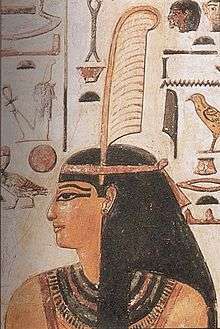
There is little surviving literature that describes the practice of ancient Egyptian law. Maat was the spirit in which justice was applied rather than the detailed legalistic exposition of rules. Maat represented the normal and basic values that formed the backdrop for the application of justice that had to be carried out in the spirit of truth and fairness. From the Fifth Dynasty (c. 2510–2370 BCE) onwards, the vizier responsible for justice was called the Priest of Maat and in later periods judges wore images of Maat.[13]
Later scholars and philosophers also would embody concepts from the Sebayt, a native wisdom literature. These spiritual texts dealt with common social or professional situations, and how each was best to be resolved or addressed in the spirit of Maat. It was very practical advice, and highly case-based, so few specific and general rules could be derived from them.[14]
During the Greek period in Egyptian history, Greek law existed alongside Egyptian law. The Egyptian law preserved the rights of women, who were allowed to act independently of men and own substantial personal property, and in time, this influenced the more restrictive conventions of the Greeks and Romans.[15] When the Romans took control of Egypt, the Roman legal system, which existed throughout the Roman Empire, was imposed in Egypt.
Scribes
Scribes held prestigious positions in ancient Egyptian society in view of their importance in the transmission of religious, political, and commercial information.[16]
Thoth was the patron of scribes who is described as the one "who reveals Maat and reckons Maat; who loves Maat and gives Maat to the doer of Maat".[17] In texts such as the Instruction of Amenemope the scribe is urged to follow the precepts of Maat in his private life as well as his work.[18] The exhortations to live according to Maat are such that these kinds of instructional texts have been described as "Maat Literature".[19]
Goddess
| ||||||||||||||||||||||||||||||
| Goddess Maat[20][21] in hieroglyphs |
|---|
Maat was the goddess of harmony, justice, and truth represented as a young woman.[22] Sometimes she is depicted with wings on each arm or as a woman with an ostrich feather on her head.[21] The meaning of this emblem is uncertain, although the god Shu, who in some myths is Maat's brother, also wears it.[23] Depictions of Maat as a goddess are recorded from as early as the middle of the Old Kingdom (c. 2680 to 2190 BCE).[24]
The sun-god Ra came from the primaeval mound of creation only after he set his daughter Maat in place of Isfet (chaos). Kings inherited the duty to ensure Maat remained in place, and they with Ra are said to "live on Maat", with Akhenaten (r. 1372–1355 BCE) in particular emphasising the concept to a degree that the king's contemporaries viewed as intolerance and fanaticism.[25] Some kings incorporated Maat into their names, being referred to as Lords of Maat,[26] or Meri-Maat (Beloved of Maat).
Maat had an invaluable role in the ceremony of the Weighing of the Heart.
Temples
The earliest evidence for a dedicated temple is in the New Kingdom (c. 1569 to 1081 BCE) era, despite the great importance placed on Maat. Amenhotep III commissioned a temple in the Karnak complex, whilst textual evidence indicates that other temples of Maat were located in Memphis and at Deir el-Medina.[27] The Maat temple at the Karnak complex was also used by courts to meet regarding the robberies of the royal tombs during the rule of Ramesses IX.[23]
Afterlife
Weighing of the Heart
In the Duat, the Egyptian underworld, the hearts of the dead were said to be weighed against her single "Feather of Maat", symbolically representing the concept of Maat, in the Hall of Two Truths. This is why hearts were left in Egyptian mummies while their other organs were removed, as the heart (called "ib") was seen as part of the Egyptian soul. If the heart was found to be lighter or equal in weight to the feather of Maat, the deceased had led a virtuous life and would go on to Aaru. Osiris came to be seen as the guardian of the gates of Aaru after he became part of the Egyptian pantheon and displaced Anubis in the Ogdoad tradition. A heart which was unworthy was devoured by the goddess Ammit and its owner condemned to remain in the Duat.[28]
The weighing of the heart, pictured on papyrus in the Book of the Dead typically, or in tomb scenes, shows Anubis overseeing the weighing and Ammit seated awaiting the results so she could consume those who failed. The image would be the vertical heart on one flat surface of the balance scale and the vertical Shu-feather standing on the other balance scale surface. Other traditions hold that Anubis brought the soul before the posthumous Osiris who performed the weighing. While the heart was weighed the deceased recited the 42 Negative Confessions as the Assessors of Maat looked on.[28]
Funerary texts
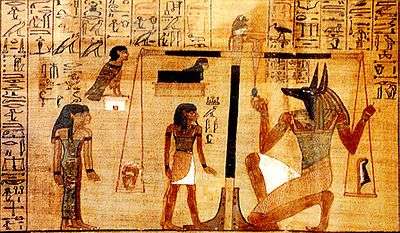
Egyptians were often entombed with funerary texts in order to be well equipped for the afterlife as mandated by ancient Egyptian funerary practices. These often served to guide the deceased through the afterlife, and the most famous one is the Book of the Dead or Papyrus of Ani (known to the ancient Egyptians as The Book of Coming Forth by Day). The lines of these texts are often collectively called the "Forty-Two Declarations of Purity".[29] These declarations varied somewhat from tomb to tomb as they were tailored to the individual, and so cannot be considered a canonical definition of Maat. Rather, they appear to express each tomb owner's individual practices in life to please Maat, as well as words of absolution from misdeeds or mistakes, made by the tomb owner in life, which could be declared as not having been done, and through the power of the written word, wipe particular misdeed from the afterlife record of the deceased. Many of the lines are similar, however, and paint a very unified picture of Maat.[29]
The doctrine of Maat is represented in the declarations to Rekhti-merti-f-ent-Maat and the 42 Negative Confessions listed in the Papyrus of Ani. The following are translations by E. A. Wallis Budge.[29]
42 Negative Confessions (Papyrus of Ani)
From the Papyrus of Ani.
- I have not committed sin.
- I have not committed robbery with violence.
- I have not stolen.
- I have not slain men and women.
- I have not stolen grain.
- I have not purloined offerings.
- I have not stolen the property of the gods.
- I have not uttered lies.
- I have not carried away food.
- I have not uttered curses.
- I have not committed adultery.
- I have made none to weep.
- I have not eaten the heart [i.e., I have not grieved uselessly, or felt remorse].
- I have not attacked any man.
- I am not a man of deceit.
- I have not stolen cultivated land.
- I have not been an eavesdropper.
- I have slandered no man.
- I have not been angry without just cause.
- I have not debauched the wife of any man.
- I have not debauched the wife of any man (repeats the previous affirmation but addressed to a different god).
- I have not polluted myself.
- I have terrorized none.
- I have not transgressed the Law.
- I have not been wroth.
- I have not shut my ears to the words of truth.
- I have not blasphemed.
- I am not a man of violence.
- I am not a stirrer up of strife (or a disturber of the peace).
- I have not acted (or judged) with undue haste.
- I have not pried into matters.
- I have not multiplied my words in speaking.
- I have wronged none, I have done no evil.
- I have not worked witchcraft against the King (or blasphemed against the King).
- I have never stopped the flow of water.
- I have never raised my voice (spoken arrogantly, or in anger).
- I have not cursed or blasphemed God.
- I have not acted with evil rage.
- I have not stolen the bread of the gods.
- I have not carried away the khenfu cakes from the spirits of the dead.
- I have not snatched away the bread of the child, nor treated with contempt the god of my city.
- I have not slain the cattle belonging to the god.[30][31]
Assessors of Maat
The Assessors of Maat are the 42 deities listed in the Papyrus of Nebseni,[32] to whom the deceased make the Negative Confession in the Papyrus of Ani.[33] They represent the 42 united nomes of Egypt, and are called "the hidden Maati gods, who feed upon Maat during the years of their lives;" i.e., they are the righteous minor deities who deserve offerings.[29] As the deceased follows the set formula of Negative Confessions, he addresses each god directly and mentions the nome of which the god is a patron, in order to emphasize the unity of the nomes of Egypt.[32]
Gallery
- Statuette of a kneeling man, maybe a priest, offering a small Maat figure. Bronze with agemina. Third Intermediate Period/Late Period
 Ancient artisans’ village Deir el-Medina in Upper Egypt
Ancient artisans’ village Deir el-Medina in Upper Egypt- Relief of Maat in east upstairs. Temple of Edfu, Upper Egypt
_-_Egypt-5A-044.jpg)
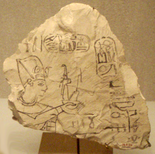 Ostracon depicting the pharaoh Ramesses IX presenting Maat
Ostracon depicting the pharaoh Ramesses IX presenting Maat- Relief in the inner room of Hathor's temple in Deir el-Medina
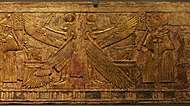 Maat represented with wings
Maat represented with wings Bas-relief depicting the Egyptian statuette of Maat. Old Kingdom
Bas-relief depicting the Egyptian statuette of Maat. Old Kingdom
References
Citations
- Allen, James P. Middle Egyptian: An Introduction to the Language and Culture of Hieroglyphs. Cambridge University Press. p. 147. ISBN 9781139917094.
- Allen, James P. (2013-07-11). The Ancient Egyptian Language: An Historical Study. Cambridge University Press. ISBN 9781107032460.
- "Coptic Dictionary Online". corpling.uis.georgetown.edu. Retrieved 2017-03-16.
- Siegfried Morenz (1973). Egyptian Religion: Siegried Morenz. p. 273. ISBN 978-0-8014-8029-4.
- Budge. The Gods of the Egyptians Vol. 1 p. 418.
- Henrietta McCall (January 1990). Mesopotamian myths. University of Texas Press. p. 46. ISBN 0-292-72076-9.
- Denise Martin (2008). Maat and order in African Cosmology: A Conceptual Tool for Understanding Indigenous Knowledge. p. 951.
- Norman Rufus Colin Cohn (1993). Cosmos, Chaos and the World to Come: The Ancient Roots of Apocalyptic Faith. p. 9. ISBN 978-0-300-05598-6.
- John Romer, Testament, pp. 41–42, Guild Publishing, 1988.
- Religion and Cultural Memory: Ten Studies, Jan Assmann, Translated by Rodney Livingstone, p. 34, Stanford University Press, 2006, ISBN 0-8047-4523-4.
- James P. Allen (2000). Middle Egyptian: An Introduction to the Language and Culture of Hieroglyphs. p. 116. ISBN 978-0-521-77483-3.
- Frankfort, Henri. Ancient Egyptian Religion. p. 62.
- Siegfried Morenz (1973). Egyptian Religion: Siegried Morenz. pp. 117–125. ISBN 978-0-8014-8029-4.
- Roland Murphy (2012). The Interpretation of Old Testament Wisdom Literature.
- Anton Powell (1995). The Greek World. Psychology Press. p. 303. ISBN 978-0-415-17042-0.
- Black, p. 130
- Black, p. 131
- Black, p. 132
- Black, p. 157
- Hieroglyphs can be found in (Collier and Manley pp. 27, 29, 154)
- Budge The Gods of the Egyptians Vol. 1 p. 416
- Robert A. Armour (2001). Gods and Myths of Ancient Egypt. American University in Cairo Press. ISBN 978-977-424-669-2.
- "The Oxford Encyclopedia of Ancient Egypt" Vol. 2 p. 320
- The Oxford Essential Guide to Egyptian Mythology, Edited by Donald B. Redford, p. 190, Berkeley, 2003, ISBN 0-425-19096-X
- Ray, John D. Reflections on Osiris, p. 64, Profile books, 2002, ISBN 186197 490 6; An inscription of Hatshepsut reads "I have made bright the truth which he [Amun-Re] loved, [I] know that he liveth by it the truth[Maat]; it is my bread, I eat of its brightness" (Breasted Records, V2, p. 123)
- Barry J. Kemp (2005). 100 hieroglyphs: think like an Egyptian. ISBN 1-86207-658-8.
- The Essential Guide to Egyptian Mythology: The Oxford Guide, p. 190, Berkeley Reference, 2003, ISBN 0-425-19096-X
- "Death in Ancient Egypt: Weighing the Heart". British Museum. British Museum. Retrieved May 2, 2014.
- "The Papyrus of Ani".
- The Book of the Dead. Gramercy. 1995-01-23. pp. 576–582. ISBN 978-0-517-12283-9.
- Sir Ernest Alfred Wallis Budge (1913). The Papyrus of Ani: A Reproduction in Facsimile, Edited, with Hieroglyphic Transcript, Translation, and Introduction. Medici Society. pp. 576–582.
Image of p. 576 & p. 577 & p. 578 & p. 579 & p. 580 & p. 581 & p. 582 at Google Books
- "Papyrus of Nebseni". Retrieved May 2, 2014.
- Budge The Gods of the Egyptians Vol. 1 pp. 418–20
Bibliography
- Black, James Roger. The Instruction of Amenemope: A Critical Edition and Commentary – Prolegomenon and Prologue, Dissertation University of Wisconsin-Madison, 2002
- Budge, E. A. Wallis. The Egyptian Book of the Dead: (The Papyrus of Ani) Egyptian Text Transliteration and Translation. New York: Dover Publications, 1967. Originally published in 1895.
- Budge, E. A. Wallis. The Gods of the Egyptians: Studies in Egyptian Mythology – Volume 1. New York: Dover Publications, 1969. Originally published in 1904.
- Collier, Mark and Manly, Bill. How to Read Egyptian Hieroglyphs: Revised Edition. Berkeley: University of California Press, 1998.
- Faulkner, Raymond. The Egyptian Book of the Dead. San Francisco: Chronicle Books, 1994. ISBN 0-8118-6489-8
- Mancini, Anna. Maat Revealed: Philosophy of Justice in Ancient Egypt. New York: Buenos Books America, 2004.
- Strudwick, Helen. (2006). The Encyclopedia of Ancient Egypt. Singapore: De Agostini UK.
- Journey through the afterlife, Ancient Egyptian Book of the Dead edited by John H. Taylor (the British Museum Press 2010. London ISBN 0-7141-1989-X)
Further reading
- Assmann, Jan (1990). Maʽat: Gerechtigkeit und Unsterblichkeit im Alten Ägypten (in German). C.H. Beck Verlag. ISBN 3406346677.
- Menu, Bernadette (2005). Maât: L'ordre juste du monde (in French). Editions Michalon. ISBN 2841862836.